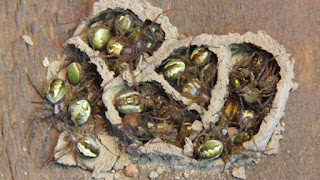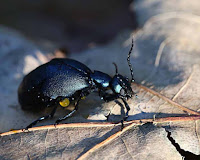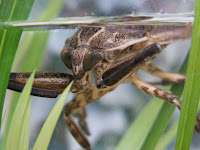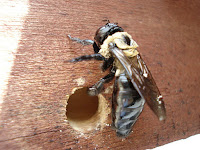Utilizing Insects.
Giant insects are a D&D stand by. It's hard to find a dungeon that doesn't at least have a few giant beetles spewing toxic fluids around. Admittedly they are one of my own favorite go to monsters.
One thing I think has been slightly overlooked of the the years are the myriad of real hunting and defensive mechanisms insects employ. If by making any old insect "giant" it becomes that much more dangerous why not extrapolate some of their more exotic abilities into the realm of fantasy as well. Now I'm not crazy enough to think I can write about even a small percentage of insects in this format. Instead I'm going to try and hit on some of my favorites.
Wasps and Hornets:
I love wasps. Few things interest me more than all the different ways they have found to survive. Aerial hunters extraordinaire it seems that these gals have evolved hundreds of ways to attack and kill prey.
One thing to think about is wasps are in many cases ambush predators, waiting around in areas where they know prey will be and striking with surprise. Generally an ambushing wasp will find a perch or a hidden place to hover and wait for prey. For example the Vespa Bicolor Hornet will sit on pile of dung waiting for flies it to attract flies. Once the fly get close sounge the honest strikes snatching them up.
One thing to think about is wasps are in many cases ambush predators, waiting around in areas where they know prey will be and striking with surprise. Generally an ambushing wasp will find a perch or a hidden place to hover and wait for prey. For example the Vespa Bicolor Hornet will sit on pile of dung waiting for flies it to attract flies. Once the fly get close sounge the honest strikes snatching them up.
Using that as a template and moving it into the fantasy realm I could imagine a breed of giant paper wasps that use man made mines as shelter. The wasps are golden grey color with a splash of red on their foreheads. Their wings are silky black in color. Their bodies long, with powerful pincers, and thick legs. The wasps abdomens are almost round, striped black and dull grey-gold. Overall they are about the size of a large dog.
Their nests are made of digested wood pulp held together with wasp secretions and mud from the cave floors. The nests are large, housing 1d12 adult wasps, gray, usually built in dark places, and can easily go unnoticed.
The wasps are attracted to gold. When gold is unearthed or stored in an area, a single wasp will fly to the location and land in the darkest corner of the room. When living creatures are around the wasp will wait until one is quite close (Moderate difficulty to detect the wasp) then fly out attacking the target from behind usually aiming at the neck. If the wasp kill a target they will immediately begin excising hunks of flesh and flying them back to the nest. The wasp will bite twice a round until A: The target dies. B: The wasp is reduced to 1/2 hit points at which point it will try to escape.
The wasps are attracted to gold. When gold is unearthed or stored in an area, a single wasp will fly to the location and land in the darkest corner of the room. When living creatures are around the wasp will wait until one is quite close (Moderate difficulty to detect the wasp) then fly out attacking the target from behind usually aiming at the neck. If the wasp kill a target they will immediately begin excising hunks of flesh and flying them back to the nest. The wasp will bite twice a round until A: The target dies. B: The wasp is reduced to 1/2 hit points at which point it will try to escape.
This type of wasp only stings if cornered or if defending the nest. IN these situations wasps will buzz a target and attempt to jab with it's barb like stinger. The sting does light damage but causes searing pain. The target must make a constitution save. or lose 1d6+4 strength for 5 rounds from the debilitating pain.
Spider hunting Wasps are another interesting take:
They are a classification of wasps that contains over 200 species which hunt, and paralyze spiders. Known broadly as spider wasps, they drag the spiders back to their nests and lay eggs on their paralyzed victims. The larvae once hatched eat spider alive. Horror movie level insect on arachnid violence.
They are a classification of wasps that contains over 200 species which hunt, and paralyze spiders. Known broadly as spider wasps, they drag the spiders back to their nests and lay eggs on their paralyzed victims. The larvae once hatched eat spider alive. Horror movie level insect on arachnid violence.
 |
| Ohh god, why did I ever look this up? |
Again extrapolating things to the D&D fantasy level... Giant spiders are a D&D stand by. If there are giant spiders why not giant angry ass wasps that eat them?
A giant-spider wasps nest would be a massively disturbing thing to run into. Scores of paralyzed spiders being slowly eaten by giant grubs. Beyond the horrid visual however it's not particularly threatening to your players.
So lets switch it up. How about the grub uses the giant spider to ACTIVELY feed? The grub latches onto the spider and through chemicals or hunger the arachnid goes into a hunting frenzy. Feeling no pain and knowing no fear the berserk grub infested spider falls on prey and attacks until the target is dead and the spider can feed, giving more nutrients to the parasitic grub. Furthermore these grub controlled spiders can hibernate within the thin mud walls of a nest, waiting to burst fourth when warm blooded prey wonders close enough. Nothing says , "RUN!" like a desiccated mindlessly attacking giant spider which moves like a stiff marionette.
Another hook for a mid level adventure might involve solitaire "spider " wasps that have adapted to attack other prey. Sheep disappearing with out a trace, or town guards going missing with just their helmets left behind could be a nice set up for a short adventure.
Some Beetle Defenses:
Blister beetles are cool little buggers when disturbed they secrete a yellow oily substance that not oily burns flesh but is also highly poisonous. So a giant version of this critter might leave puddles of the juice in it's wake once disturbed. So if there are a bunch of them in a room and a party lumbers in they could all scurry away leaving wide trails of corrosive poison in their wake effectively making the area where the party is walking much harder to navigate. A monster that can be used to complicate the environment rather than attacking the party directly. Larger beetles mean stronger secretion so any objects that come into contact with the juice should also require a saving throw. Much like a rust monster the parties equipment could be at risk as well as the party members themselves.
The Bombardier beetle is well known for the nasty, hot, chemical spray that gives the beetle it's name. I even found a "giant" version stated out for D20 games.
Out there on the interwebs there is a heated (pun ) argument about whether or not the humble Bombardier beetle should be the poster bug for intelligent design. Some folks say that this bug could never have evolved such a finely tuned chemical defense because precursor beetles would have blown themselves up before the mechanism could have fully evolved. Or else those precursor bugs would have been overly burdened with useless chemical crap in their abdomens, and again never would have survived evolution.
Fine. I'll let more educated people argue about design vs evolution, for my uses they had me at
What I would like to see is a queen beetle whose male drones explode if threatened. The party stumbles on the egg chamber of the beetles burrow and the drones charge exploding one after another in plumes of superheated hydroquinones and hydrogen peroxide. Leaving the Unlucky party caught in what is effectively a cloudkill spell that has the duration of 1 minute per beetle. These beetles lay their eggs in damp places, the eggs if collected by hardy adventurers could be used to start camp fires , or blow up kobolds.
Botflys:
I will not be sharing any of these pictures because I regret seeing them in the first place.
The interesting part of this for me is that the fly captures mosquito, attaches their egg to the mosquito, the egg hatches on the mosquito and use the mosquito bite as an entry point on some poor person. The larva then feeds on the person and develops under their skin, causing a large bump and all kinds of hideousness.
The fly uses the mosquito as a vector to infect another animal.... (Crazy)
Now I think giant grub being inserted into an adventurer by a giant mosquito is cool, but it has been done I'm sure. What about using other things as unsuspecting vectors?
For example A breed of spider that lays small web sacks on the ends of mettle objects. If the spider gets lucky it has found a sword or spear. If it's VERY lucky it's eggs will get stabbed into some unfortunate host where they will grow into spiderlings and cause all kinds of organ failure in a month or so. This kind of thing would have tells. Like a festering wound, swelling, or actual visible spider-lings under the victims skin. A priest could cure disease, a ranger could identify the problem, a druid may be able to use magic or herbalism to cure the poor soul. That character will likely never sleep again.
Another thought for this secondary vector idea is an insect that uses this process to control other
animals. A Huge water bug that uses expelled Co2 to attract mosquitoes (always the mosquitoes right?) and coats them with chemicals, which make the next mammal they bite become incredibly thirsty. The thirsty animal seeks water, where the water bug lies in wait where it will ambush the victim. Characters could get a save vs the thirst, where if they pass it they would know something is not right that the thirst is terrible and far too sudden.
These are just some quick ideas from some cursory searches about insects and how they hunt, reproduce, and defend themselves.
I'm sure there's an untold number of cool things waiting out there for us when we start digging.
I thing the real take away here is that if you hear something interesting about the natural world, let nature do some of the work for you. Stretch the concept in your head until it is something that belongs in a fantasy setting. Ideas based even loosely in the real world will ring a bit more true, a bit less strange , so that the real fantastic or strange stuff will stand out that much more.
Thanks for reading ,
-Mark.
(Is that a giant carpenter bee in the side of your ship?)
Sources:
A giant-spider wasps nest would be a massively disturbing thing to run into. Scores of paralyzed spiders being slowly eaten by giant grubs. Beyond the horrid visual however it's not particularly threatening to your players.
So lets switch it up. How about the grub uses the giant spider to ACTIVELY feed? The grub latches onto the spider and through chemicals or hunger the arachnid goes into a hunting frenzy. Feeling no pain and knowing no fear the berserk grub infested spider falls on prey and attacks until the target is dead and the spider can feed, giving more nutrients to the parasitic grub. Furthermore these grub controlled spiders can hibernate within the thin mud walls of a nest, waiting to burst fourth when warm blooded prey wonders close enough. Nothing says , "RUN!" like a desiccated mindlessly attacking giant spider which moves like a stiff marionette.
Another hook for a mid level adventure might involve solitaire "spider " wasps that have adapted to attack other prey. Sheep disappearing with out a trace, or town guards going missing with just their helmets left behind could be a nice set up for a short adventure.
Some Beetle Defenses:
 |
| source |
The Bombardier beetle is well known for the nasty, hot, chemical spray that gives the beetle it's name. I even found a "giant" version stated out for D20 games.
Out there on the interwebs there is a heated (pun ) argument about whether or not the humble Bombardier beetle should be the poster bug for intelligent design. Some folks say that this bug could never have evolved such a finely tuned chemical defense because precursor beetles would have blown themselves up before the mechanism could have fully evolved. Or else those precursor bugs would have been overly burdened with useless chemical crap in their abdomens, and again never would have survived evolution.
Fine. I'll let more educated people argue about design vs evolution, for my uses they had me at
"If it exploded inside, it would blow any Bombardier Beetle to smithereens."
 |
| Source |
Botflys:
I will not be sharing any of these pictures because I regret seeing them in the first place.
I don't suggest it, but you want search "Human Botfly" And see for yourself. Don't blame me for it though.
The interesting part of this for me is that the fly captures mosquito, attaches their egg to the mosquito, the egg hatches on the mosquito and use the mosquito bite as an entry point on some poor person. The larva then feeds on the person and develops under their skin, causing a large bump and all kinds of hideousness.
The fly uses the mosquito as a vector to infect another animal.... (Crazy)
Now I think giant grub being inserted into an adventurer by a giant mosquito is cool, but it has been done I'm sure. What about using other things as unsuspecting vectors?
For example A breed of spider that lays small web sacks on the ends of mettle objects. If the spider gets lucky it has found a sword or spear. If it's VERY lucky it's eggs will get stabbed into some unfortunate host where they will grow into spiderlings and cause all kinds of organ failure in a month or so. This kind of thing would have tells. Like a festering wound, swelling, or actual visible spider-lings under the victims skin. A priest could cure disease, a ranger could identify the problem, a druid may be able to use magic or herbalism to cure the poor soul. That character will likely never sleep again.
 |
| Source |
animals. A Huge water bug that uses expelled Co2 to attract mosquitoes (always the mosquitoes right?) and coats them with chemicals, which make the next mammal they bite become incredibly thirsty. The thirsty animal seeks water, where the water bug lies in wait where it will ambush the victim. Characters could get a save vs the thirst, where if they pass it they would know something is not right that the thirst is terrible and far too sudden.
These are just some quick ideas from some cursory searches about insects and how they hunt, reproduce, and defend themselves.
I'm sure there's an untold number of cool things waiting out there for us when we start digging.
I thing the real take away here is that if you hear something interesting about the natural world, let nature do some of the work for you. Stretch the concept in your head until it is something that belongs in a fantasy setting. Ideas based even loosely in the real world will ring a bit more true, a bit less strange , so that the real fantastic or strange stuff will stand out that much more.
Thanks for reading ,
-Mark.
(Is that a giant carpenter bee in the side of your ship?)
Sources:
http://www.vespa-bicolor.net/main/observations/hunting-strategy.htm
Spider wasp:
http://www.stuff.co.nz/southland-times/76985720/dining-in--mason-wasp-eats-fresh
Insect size:
http://www.aps.anl.gov/Science/Highlights/2007/20070808.htm
Painful wasp stings...Why you don't ant to get stung by a tarantula hawk? Like you had to ask?
http://www.sciencefriday.com/articles/why-you-dont-want-to-get-stung-by-a-tarantula-hawk/
Fucking NOPE..Just No...Some people ...man...
Bombardier beetle
Wikipedia has a list of D&D monsters .... Who knew? Is The giant tick really the grand daddy o fall D&D insects?
http://www.talkorigins.org/faqs/bombardier.html
https://www.dnd-spells.com/spell/cloudkill
Fuck botflys seriously , I'm never going near the equator.
https://phys.org/news/2013-07-ambush-giant-bug-lethocerus-patruelis.html
Spider wasp:
http://www.stuff.co.nz/southland-times/76985720/dining-in--mason-wasp-eats-fresh
Insect size:
http://www.aps.anl.gov/Science/Highlights/2007/20070808.htm
Painful wasp stings...Why you don't ant to get stung by a tarantula hawk? Like you had to ask?
http://www.sciencefriday.com/articles/why-you-dont-want-to-get-stung-by-a-tarantula-hawk/
Fucking NOPE..Just No...Some people ...man...
Bombardier beetle
Wikipedia has a list of D&D monsters .... Who knew? Is The giant tick really the grand daddy o fall D&D insects?
http://www.talkorigins.org/faqs/bombardier.html
https://www.dnd-spells.com/spell/cloudkill
Fuck botflys seriously , I'm never going near the equator.
https://phys.org/news/2013-07-ambush-giant-bug-lethocerus-patruelis.html




Comments
Post a Comment